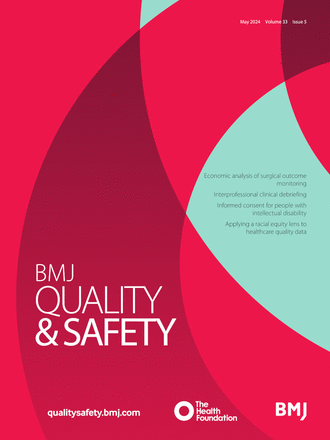Patient and caregiver perspectives on causes and prevention of ambulatory adverse events: multilingual qualitative study
IF 5.6
1区 医学
Q1 HEALTH CARE SCIENCES & SERVICES
引用次数: 0
Abstract
Context Ambulatory adverse events (AEs) affect up to 25% of the global population and cause over 7 million preventable hospital admissions around the world. Though patients and caregivers are key actors in promoting and monitoring their own ambulatory safety, healthcare teams do not traditionally partner with patients in safety efforts. We sought to identify what patients and caregivers contribute when engaged in ambulatory AE review, focusing on under-resourced care settings. Methods We recruited adult patients, caregivers and patient advisors who spoke English, Spanish and/or Cantonese, from primary care clinics affiliated with a public health network in the USA. All had experience taking or managing a high-risk medication (blood thinners, insulin or opioid). We presented two exemplar ambulatory AEs: one involving a warfarin drug-drug interaction, and one involving delayed diagnosis of colon cancer. We conducted semistructured focus groups and interviews to elicit participants’ perceptions of causal factors and potential preventative measures for similar AEs. The study team conducted a mixed inductive-deductive qualitative analysis to derive major themes. Findings The sample included 6 English-speaking patients (2 in the focus group, 4 individual interviews), 6 Spanish-speaking patients (individual interviews), 4 Cantonese-speaking patients (2 in the focus group, 2 interviews), and 6 English-speaking patient advisors (focus group). Themes included: (1) Patients and teams have specific safety responsibilities; (2) Proactive communication drives safe ambulatory care; (3) Barriers related to limited resources contribute to ambulatory AEs. Patients and caregivers offered ideas for operational changes that could drive new safety projects. Conclusions An ethnically and linguistically diverse group of primary care patients and caregivers defined their agency in ensuring ambulatory safety and offered pragmatic ideas to prevent AEs they did not directly experience. Patients and caregivers in a safety net health system can feasibly participate in AE review to ensure that safety initiatives include their valuable perspectives. Data are available upon reasonable request.患者和护理人员对门诊不良事件的原因和预防的看法:多语种定性研究
背景 非住院不良事件(AEs)影响着全球高达 25% 的人口,并导致全球超过 700 万例可预防的入院治疗。虽然患者和护理人员是促进和监控自身非住院安全的关键参与者,但医疗团队在传统上并不与患者合作开展安全工作。我们试图找出患者和护理人员在参与门诊 AE 审查时的贡献,重点关注资源不足的医疗机构。方法 我们从美国公共卫生网络下属的初级保健诊所招募了会讲英语、西班牙语和/或广东话的成年患者、护理人员和患者顾问。他们都有服用或管理高风险药物(血液稀释剂、胰岛素或阿片类药物)的经验。我们介绍了两例门诊 AE:一例涉及华法林药物间相互作用,一例涉及结肠癌诊断延迟。我们开展了半结构化焦点小组和访谈,以了解参与者对类似 AE 的成因和潜在预防措施的看法。研究小组进行了归纳-演绎混合定性分析,以得出主要的主题。研究结果 样本包括 6 名讲英语的患者(焦点小组 2 人,个人访谈 4 人)、6 名讲西班牙语的患者(个人访谈)、4 名讲广东话的患者(焦点小组 2 人,访谈 2 人)和 6 名讲英语的患者顾问(焦点小组)。主题包括(1) 患者和团队负有特定的安全责任;(2) 积极主动的沟通推动了安全的非住院护理;(3) 与有限资源相关的障碍导致了非住院AE。患者和护理人员提出了可推动新安全项目的运营变革想法。结论 一群不同种族和语言的初级保健患者和护理人员明确了他们在确保门诊护理安全方面的作用,并提出了一些务实的想法来预防他们没有直接经历过的意外伤害。安全网医疗系统中的患者和护理人员可以参与到 AE 评审中,以确保安全倡议中包含他们的宝贵意见。如有合理要求,可提供相关数据。
本文章由计算机程序翻译,如有差异,请以英文原文为准。
求助全文
约1分钟内获得全文
求助全文
来源期刊

BMJ Quality & Safety
HEALTH CARE SCIENCES & SERVICES-
CiteScore
9.80
自引率
7.40%
发文量
104
审稿时长
4-8 weeks
期刊介绍:
BMJ Quality & Safety (previously Quality & Safety in Health Care) is an international peer review publication providing research, opinions, debates and reviews for academics, clinicians and healthcare managers focused on the quality and safety of health care and the science of improvement.
The journal receives approximately 1000 manuscripts a year and has an acceptance rate for original research of 12%. Time from submission to first decision averages 22 days and accepted articles are typically published online within 20 days. Its current impact factor is 3.281.
 求助内容:
求助内容: 应助结果提醒方式:
应助结果提醒方式:


